Taking a unit offline for preventative maintenance takes
a year-long planning process at the Merom Generating Station
EnergyLines October 2020
 Just like a car that requires maintenance to operate reliably, the Merom Generating Station gets preventative maintenance during scheduled outages. Often occurring in the spring when energy demand is low, generation on a single unit is halted. Boiler tubes and duct work are inspected and repaired — along with about 1,400 other tasks that must be completed in a meticulously calculated order.
Just like a car that requires maintenance to operate reliably, the Merom Generating Station gets preventative maintenance during scheduled outages. Often occurring in the spring when energy demand is low, generation on a single unit is halted. Boiler tubes and duct work are inspected and repaired — along with about 1,400 other tasks that must be completed in a meticulously calculated order.
The outage planning process takes a full year to arrange all the projects in such a way that tasks are performed at the right time. Chad Cornelius, Manager of Engineering and Performance at Merom Generating Station, explains that the process is much like maintaining a car. A mechanic wouldn’t change the oil and then take the engine apart.
“That’s why it takes a year, because we look at every one of those 1,400 items,” says Cornelius. “Our number one priority is employee safety. We review work that will improve plant operations and employee safety. Environmental compliance and changes for state inspections would be other reasons to move forward with repairs.”
Depending on the size of an outage, parts could cost up to $10 million, so exceptional care is taken to make sure that crews are putting all those pieces together in the right order. “It takes the collective effort of maintenance, engineering and the operations group to coordinate all those,” Cornelius adds.
Those factors, as well as a decrease in runtime and the COVID-19 pandemic, were instrumental in a decision to cancel maintenance outages for 2020, according to Tony Weitekamp, Maintenance Manager at the plant.
Weitekamp gives accolades to the plant employees who spend a year putting together the outage plan. “You’ve got guys maintaining and operating the plant, and also planning and coordinating the outage, and that’s one of the most positive things I’ve seen.”
With the outage cancellations, the workforce has returned to normally scheduled work to maintain reliability, which means staying current with preventative maintenance work orders and utilizing economic reserve downtimes to fix issues normally addressed during an outage, such as oil and filter changes.
Without the repairs that normally take place during an outage, there is an increased urgency with predictive maintenance. “We have the ability to look at vibration, temperatures or just different gauges and detect if something’s out of line. We’re addressing that sooner than we normally would,” Cornelius says.
One of the bigger maintenance jobs during an outage is to perform an air heater wash, because the air heaters can get plugged up. “We’ll tackle that during this economic reserve time period,” says Weitekamp, adding that he has access to the equipment needed in-house so cost is minimal. “It’s no different than if you didn’t change your furnace filter. You’re not going to get the performance out of your air conditioner at home.”
For 2021, a maintenance outage is scheduled on unit two, which equates to the normal two years of preventative maintenance, and a summer prep outage on unit one, which is one year of preventative maintenance. “This scope won’t double as far as scale on unit two, but unit one will undergo two years’ worth of maintenance,” says Weitekamp.
By early November, Weitekamp expects the winter preparation maintenance to be complete. That includes such jobs as heat trace checks on piping, covering louvers on buildings to keep the cold air out and making sure portable heaters work well.